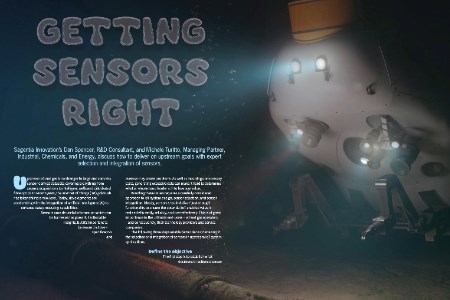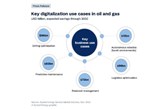Gettings sensors right
Published by Alfred Hamer,
Editorial Assistant
Oilfield Technology,
Sagentia Innovation’s Dan Spencer, R&D Consultant, and Michele Turitto, Managing Partner, Industrial, Chemicals, and Energy, discuss how to deliver on upstream goals with expert selection and integration of sensors.

Upstream oil and gas is no stranger to large and complex sensor-derived datasets, covering everything from seismic acquisitions to intelligent wells and distributed fibre optics. In recent years, the Internet of Things (IoT) goldrush has taken this to a new level. Today, developments are accelerating with the integration of artificial intelligence (AI) to enhance data processing capabilities.
Sensors provide useful information which can be harnessed as powerful actionable insights, but it’s important to be aware that over-specification and overuse may create problems. As well as incurring unnecessary costs, generating excessive data can make it hard to determine what is relevant and harder still to leverage value.
Avoiding these issues requires a carefully considered approach to IoT system design, sensor selection, and sensor integration. Ideally, sensors should deliver ‘just enough’ functionality to ensure the potential IoT-enabled value is realised efficiently, reliably, and cost-effectively. This is of great importance to the ultimate end-users – oil and gas operators – and consequently, their technology providers and service companies.
The following three steps enable better decision making in the selection and integration of sensors in upstream IoT system applications.
Define the objective
The first step is to establish what decisions or actions a sensor will enable. For upstream operations, this may entail applications such as real time production monitoring, pipeline leak detection, predictive maintenance, and environmental monitoring. Deciding exactly which factors are of interest and what insights the IoT system should convey is paramount. This ensures that sensor design and selection is laser-focused on gathering insights at the right level of detail to translate into tangible value, whether that’s in the form of personnel safety, higher operational efficiency, raising preventive alarms, or optimising production.
When defining objectives, consider the impact of false positives and false negatives. Sometimes false positives (e.g. early or unnecessary alerts) are acceptable whereas false negatives (no alert) cannot be tolerated. In other applications false positives may be highly disruptive and need to be avoided. Considering this at an early stage enables more informed decisions about the type and combination of sensors to employ.
Once a decision- or action-based objective has been established, the next task is to ascertain parameters which support it. This will vary case-by-case according to science or engineering features which underpin the wider IoT system. A detailed understanding of what is being measured and the wider operational context in which it fits is essential to right-size the IoT system and ensure only necessary data is collected. Not every piece of information is worth the cost of obtaining it.
It’s also important to think about potential interference or confusion during operations. For instance, in a noisy environment, like an offshore platform, it could prove difficult to monitor vibrations. This might demand a more sophisticated solution to measure specific vibration frequencies, or it may be more effective to focus on a different measurand.
Decide on sensor type
Some metrics have many established ways of sensing, some have only one, and some have none, so there’s great variation in the depth and breadth of available options. Compare vibrations (where an accelerometer is the standard sensor) with corrosion detection (where there are multiple methods).
On the other hand, there may be a vital metric that cannot be sensed using off-the-shelf technology, such as the presence of certain chemicals. In cases like this, it may be beneficial to invest in the development of novel sensor technologies or to adopt lab methods. Mapping the additional R&D costs against potential market gains is a simple but important way to ensure investment is focused on delivering commercial advantage.
In situations like corrosion detection where various sensor types could be applied, a systematic approach helps to ensure the best option is selected for a specific task. This requires a broad knowledge of the different sensing methodologies, as well as sensor physics, so that relevant calculations can be performed.
Suitable sensing methods for corrosion detection can include ultrasonics and radiography as well as electrical resistance and eddy current testing. Above ground detection of anomalies in the walls of buried pipelines can be achieved using magnetic tomography or magnetometry inspections. In electrolytic environments, where electrochemical corrosion can be a problem, the linear polarisation resistance method may be suitable. For pipelines, smart pigs can be equipped with multiple sensor types to detect corrosion from inside pipes.
Systematic assessment of the various sensing options also facilitates methodical consideration of factors such as ease of implementation, cost, existing IP, and robustness. This can quickly determine one or two possible sensing concepts for more detailed lab-based proof-of-concept exploration. If the technology readiness level (TRL) of identified approaches demands attention, this can become an R&D priority.
Finalise settings and thresholds
Whether there’s a single standard approach for measurement (e.g., an accelerometer) or multiple options (e.g., ultrasonic and radiographic sensing), the next step is to establish how the measurement is made in practice, and how this enables the decision- or action-based outcome.
Consider the use of an accelerometer to measure vibrations from rotating equipment. Vibrations can be generated at many different frequencies and at many different amplitudes. So, experimenting with high-spec instrumentation in a laboratory setting can be highly beneficial, reading across a wide frequency range with high fidelity to reveal the frequencies of interest. This important step ensures sensors are not over-specified, meaning costs and data handling/processing requirements are proportionate.
Exposing the system to possible confounding factors is also critical during this stage. In terms of vibrations, it is important to understand additional sources of vibration in the environment and how they affect the system. It might be that some frequencies are saturated, while others are left unaffected. Similarly, when investigating competing approaches for corrosion detection, ultrasonic techniques may give false positives due to surface roughness or debris which cause scattering from the inner surface.
Simple data analytics can be employed to investigate the data gathered by lab instrumentation. When monitoring vibration with an accelerometer, dimensionality reduction helps to pinpoint the smallest number of frequencies that provide the largest amount of relevant information. This can be achieved using principal component analysis or linear discriminant analysis. Alternatively, classification algorithms such as decision trees might be used to identify the parameters that provide the most useful information.
Simple classification algorithms can also be used to set thresholds. Equipment monitoring systems generally classify a sensor reading as ‘normal’ or ‘abnormal’, with abnormal readings creating an alarm or triggering a recommended action. The key is to choose a system that provides the necessary insight, but also balances false positives and false negatives appropriately.
To access the full version of this article and get a free trial subscription to Oilfield Technology, sign up here!
Read the article online at: https://www.oilfieldtechnology.com/special-reports/17072025/gettings-sensors-right/
You might also like
Rystad Energy: Key digital initiatives could save oil and gas industry over US$320 billion
Rystad reports on how digital innovation is changing the oilfield services sector.

